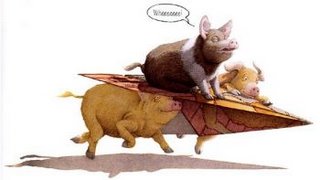 Book Review: The Three Pigs
Book Review: The Three PigsNote: This book review has been created as part of a course at TWU.
Picture courtesy of http://www.vickiblackwell.com/lit/threepigs/html
1. BIBLIOGRAPHY
Wiesner, David. 2001. THE THREE PIGS. New York, NY: Clarion Books. ISBN 0618007016
2. PLOT SUMMARY
Wiesner's tongue-in-cheek take on the classic folktale The Three Little Pigs plays with plot and perspective in a postmodern break from traditional narrative. The story begins familiarly enough, replete with beautiful Grimm's style pen and ink illustrations. Yet things go awry quickly when the wolf blows the first pig right out of the story. This, in turn, saves the pig from being eaten, allowing it to save the other two pigs. The reunited threesome then wreaks havoc on the pages of the story, using one to make a paper airplane on which to fly. After a bumpy landing, the pigs enter a nursery rhyme and classic knight's tale in succession, taking a nursery rhyme cat and the dragon with them. Upon returning to the original story, the dragon makes short work of the wolf, and the pigs, plus dragon and cat, retire to the third pig's brick house to live "happily ever after."
3. CRITICAL ANALYSIS
Wiesner's truly brilliant interplay of illustrations, text, and white space create a story that is fresh and enduring. At the beginning, The Three Pigs is as traditional as a Grimm's fairytale, with beautiful illustrations, but as soon as the first pig is blown out of the story, the illustrations take on a life of their own. Any part of a character which has escaped from its text is drawn in pen and ink in a more realistic manner, with three dimensionality and shading. One of my favorite examples of this is when the pigs enter the nursery rhyme "Hey Diddle Diddle." Unless the reader is looking closely, she might not notice that the cat with the fiddle has one paw outside the text, but it foreshadows the cat's imminent escape to join the pigs.
Yet the escaped characters are not the only ones affected by the blurring of textual boundaries. If one looks closely at the pages left behind, one will notice that the characters and story have changed to reflect the absence of one or more characters. This is best represented near the end of the story when the pigs, cat, and dragon are roaming between pages of stories which surround them like rows of walls reminiscent of "The Matrix." On this page, flying fish and a little boy appear to be gaping at the entourage from their story.
Wiesner plays with perspective as well. First, in depicting the three pigs flying on a paper airplane made from one of the pages of their story, the author uses the white space of the book to show them zooming in toward the reader, then away to the very upper corner of the text. In another case of tinkering with perspective, one of the pigs is illustrated up close, its face filling more than a page, as if inspecting the reader while commenting, "I think...someone's out there."
The Three Pigs plays with text, illustration, and tradition in many other ways that beg the reader to open the book again and again. Each reading brings new discoveries and new life to an old beloved story.
Wiesner won his second Caldecott Award for this book in 2002. His first Caldecott was awarded for his book, Tuesday.
4. REVIEW EXCERPT(S)
BOOKLIST: Starred review. "Wiesner has created a funny, wildly imagined tale that encourages kids to leap beyond the familiar, to think critically about conventional stories and illustration, and perhaps to flex their imaginations and create wonderfully subversive versions of their own stories."
SCHOOL LIBRARY JOURNAL: Starred review. "Witty dialogue and physical comedy abound in this inspired retelling of a familiar favorite."
5. CONNECTIONS
*Use this book with secondary students to illustrate elements of post-modernism/point of view
*Check out this great website that has lots of ideas for using the book in the classroom: http://www.vickiblackwell.com/lit/threepigs.html
*Find other books that play with perspective such as Wiesner's wordless picture book FREE FALL (ISBN 068810990X) or Istvan Banyai's ZOOM (ISBN 0140557741) and RE-ZOOM (ISBN 014055694X)
*Collect several versions of The Three Little Pigs to compare and contrast.


No comments:
Post a Comment